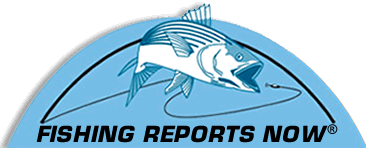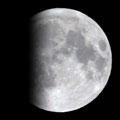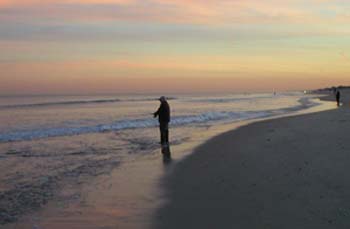| Brigantine or Bust To catch in the surf in fall, there's no better beach. By Mark Marquez II |
||
|
Anticipation. Fishing is about suspense, dreaming, looking forward. Am I going to catch? When? The more anticipation builds, Surf fishing takes patience. But put in the time, and you’ll be fine. And the best chances loom in By mid October surf angling in Jersey is building steam. |
|
Baitfish including adult bunker, peanut bunker and mullet are Both will rip through the bait, gorge themselves to prepare for winter, Surf anglers in New Jersey will intercept them at the beaches that attract the most fish.
When? Where? Brigantine has become one of New Jersey’s best areas to intercept the fall migration of stripers and blues in the surf. How come? Sandbars and troughs build along the shoreline of the island, said Capt. Andy Grossman, owner of Riptide Bait & Tackle in Brigantine. Baitfish hide in the ups and downs, attracting bass and blues. Other areas along Jersey’s shoreline are often flat, he said. That’s his guess, anyway, he said. Other possibilities include that Brigantine somewhat juts out into the ocean. Notice that many areas known for surf fishing, such as Montauk and Cape Hatteras, are points of land along the coast. Another guess is that Brigantine is surrounded by all kinds of waters, bays, channels, other islands, the ocean – a rich estuary of food and forage. Whatever the reasons, some of the best surf-fishing reports roll in from Brigantine year after year. Bluefish hit the wash weeks before stripers do. Traditionally the first big, migrating stripers – not the smaller, “resident” stripers that grew up and live in the area, yet to migrate – start to arrive in the first couple of weeks of October, Andy said. Six or eight stripers in the 20-pound class might be reported caught, That’s certainly a time to ply the beach, but the fishing can be off and on for a moment. At some point the linesiders swarm everywhere. The first couple of weeks of November, give or take a few days, is usually a good bet anywhere in the state. Most surf anglers on Brigantine fish with bait, Andy said. Some prefer lures, but lure fishing attracts more of a following farther north in the state, for whatever reasons. Most of the island’s sharpies fish for stripers with surf clam or bunker, and clam is most popular. But they also toss live eels or spots. A whole clam or a chunk of bunker, usually the bunker head, gets impaled on a 6/0 to 10/0 circle hook on a 30- to 40-pound, 24-inch leader on a fish-finder rig or a three-way-swivel rig. The bunker head is used because large stripers often swim on the bottom below bluefish that attack schools of the menhaden. The blues eat the softer body of the bunker, and the hard head falls to the bottom, where scavenger stripers pounce. Some anglers prefer fluorocarbon leaders, but Andy tells his customers that flouro is unnecessary. Stripers aren’t line shy, he says. Monofilament works and is less expensive. Eels or spots get fished on a 4/0, non-circle hook, such as a Gamakatusu Octopus, on a 36-inch leader with a drail weight or trolling weight. Eels can get tangled on a circle hook. With clams or bunker, anglers usually toss the rig in a trough between two sandbars, where fish ambush bait that gets funneled through. Troughs are found by looking for areas with no waves, because sandbars on either side cause waves, but holes do not. Live bait is usually fished along the jetties, a likely place for stripers to wait and attack. Some anglers, including Andy, like to choose a likely location to find fish, set up and wait, he said. They believe the key is to put in time and be there when fish arrive. Others like to stay on the move, trying one area a while. If they score no hook-up after a reasonable search, they relocate until they do. The locals stay in communication with others on cell phones or radios to find a bite. Outgoing tides are a favorite, because the holes and bars are easier to see as waters recede, Andy said. But others like incoming, and both tides or moving waters produce. Favorite lures for stripers on the island include Gibbs Polaris Poppers, divers like Danny plugs with a big metal lip, other types of swimmers and darters. For bait for blues, oily fish such as mullet or mackerel are hooked on a mullet rig or a fireball rig. For lures for the slammers, metal jigs like Gators or Hopkins get slung. Popular spots to fish include the cove at Absecon Inlet on the southern end of the island to the east of the inlet bridge; in front of the Brigantine Motel, especially at night, because anglers like the lighted background; the underwater jetty at 6th Street; and the beach buggy entrance at the north end of the island, where anglers can park along the sea wall and walk onto the beach. Beach buggy access is available on both the north and south ends with a beach buggy permit that can be purchased for $160, or $60 for seniors, from City Hall at 1417 Brigantine Avenue. From May 1 through September 1 permits can be purchased at Brigantine’s Beach Fee Office at 15th Street and Brigantine Avenue Bluefish will depart the local surf and migrate south first, before stripers do. Stripers can linger as late as January, depending on the weather. A cold snap will chase them away earlier during some years. But you’ve waited long enough to hook up. Anticipation is great, but it’s time to hit the beach. |
||



 Are you going to catch?
Are you going to catch?